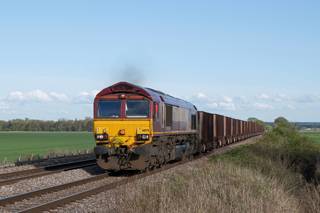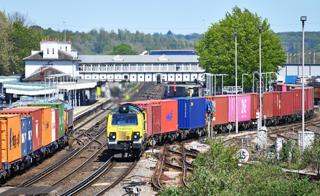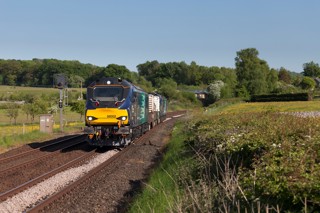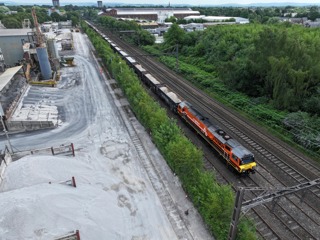Adrian Gogay doesn’t see his role as that of a station manager. For him, his role is about people management. He says being in charge of Liverpool Street station means he is responsible for every element of that station, including the people who pass through it.
And there are a lot of people who do just that without even catching a train. One way or another, 138 million people a year use Liverpool Street. As far as passenger numbers are concerned, it is the third most used station in Britain, following London Victoria and Waterloo. Add footfall to that, and it becomes the busiest.
This year, Liverpool Street has been undergoing a major rebuild and welcomed new operators to the Great Eastern Main Line terminus. And the work of Gogay and his team in managing these changes while continuing to accommodate such high numbers of passengers has earned the station a deserved accolade - this year’s National Rail Awards Major Station of the Year (RAIL 784).
Gogay is wary of taking the credit for the success, as he only moved from Victoria in May. When asked about the victory, he says, almost apologetically: “It’s a great result for the staff.”
He is responsible for 34 staff under his direct line management, while around 200 members of Abellio Greater Anglia staff also work at the station.
“We have done well. We push the ‘one team’ approach,” he says. “This has been done after bringing in the new Transport for London-backed TOCs and a new organisation of structure.”
He says that no matter which company someone works for, they all wear the same badge depicting Liverpool Street, to denote that they are all part of the same team.
“There is no one dominant TOC,” says Gogay. “Abellio has 57% of the services here and it runs the ticket office, but everyone is equal.”
Until May 2015, AGA operated all but a handful of trains into the station, with c2c running a small number in the evening. Now London Overground operates the West London inner suburban trains, while TfL Rail runs the Metro trains to Shenfield ahead of the Crossrail tunnels opening in 2019.
Gogay’s office is currently a mobile cabin near Platform 10, near where the taxis come and go. This is because the station is being partially rebuilt. There are much grander plans, but for the time being the facilities are being upgraded with the station opened up for business opportunities. And companies see the value in the station - that footfall is potential custom after all.
Gogay says the rebuild has been the biggest challenge at the station, yet there have been no complaints. Deliveries for the retail units continue, while work on Crossrail is also under way. That work has not had an adverse effect on the station, and nor has the Underground ticket office closure. The more things change, the more they stay the same!
The footfall at Liverpool Street is so high because it includes members of the public using the retail outlets and bus station. Additionally, people pass through en route to Bishopsgate and the West Mall. As a result, the station is now much busier than it used to be. Its location close to the city also helps keep the numbers high, as the local workforce descends on the station for food and shopping.
There are changes on the horizon not just for retail outlets, but for passengers as well.
Currently Liverpool Street has 18 platforms, although that will drop to 17 once Crossrail opens. However, this figure could eventually rise to 20.
Initially Platform 18 will close, because of the need to extend Platforms 16 and 17 to accommodate Crossrail’s new trains. The nine-car Class 345 Aventras that will serve the station are much longer than the current Metro trains, so the infrastructure must be accommodated accordingly. And there is little scope to do the work.
“It is a tight window - the work must be done ready for the tunnel to open, so it will be done in May to December 2019,” explains Gogay.
The tunnel he refers to is at Pudding Mill Lane, where Crossrail trains will leave the Great Eastern Main Line and head into the capital. Some Crossrail trains will continue to serve Liverpool Street, but until the platforms are lengthened, those trains will be shorter. That is why the Class 345s unveiled by Crossrail and Transport for London on November 20 (see pages 28-29) will initially be delivered as seven-car trains, before being extended to nine vehicles eventually.
In the longer term there is talk of a Platform 0, although this would be unlikely because of the aspirations to run 12-car trains on the West Anglia route. Other options to increase capacity are therefore being explored.
“The plan is to put two or three platforms in, potentially,” Gogay tells RAIL. These would be built where the new mezzanine facilities are being constructed, but would not be done for several years.
“It’s at the early stages. Conversations have been had, and are ongoing,” he says.
There is the option to rebuild the platforms by taking one or two out of use at a time, as per London Bridge. The roof support is currently between the tracks, and a solution is being investigated whereby moving that could create more space - platforms could be built where the track is, and track where the platforms are. Shifting these along towards Platform 1 would then create space for the three new platforms.
“The need is driven by growth,” says Gogay. There is also the possibility of two new tracks built into the throat of Liverpool Street, although this would require substantial infrastructure improvements.
“We need to get the station ready for growth. We have to see what we can do to be ready,” explains Gogay, pointing out that the case for this work is helped by the growth at the airports it serves.
This is merely one of several ongoing projects, another of which is a £30 million project for the roof. The day before, when going through Liverpool Street, I had noticed how dirty the roof above the station was. On Twitter, there was some debate as to what could be done, and whether the work carried out to clean the roof at London Paddington could be replicated at Liverpool Street. No, it seems, is the answer.
“We are very much aware of the roof, but we can’t do anything as it is life-expired in about five or six years time,” explains Gogay.
“The structural integrity is not good. What took place elsewhere we had looked at doing, but we are leaving it. It will need a full-scale replacement, and that will be done with a crash deck. Victoria was the pioneer for that, and that is the method we will use.”
A key market for Liverpool Street is Stansted Airport, for which trains start at 0340 and finish at 2325. Trains for other destinations leave the station even later than that, with the 0103 to Chingford the last departure on November 20 (the day of RAIL’s visit).
Says Gogay: “We are always looking at ways to change for Stansted. Southend is growing, too. There is interface with the both of them, although of course Southend is smaller. One thing to bear in mind is their size.”
RAIL visited the station a week after the deadly attacks on Paris. Had they had an effect on security measures, bearing in mind the station’s proximity to the City and the airport traffic?
“We are one of the few Network Rail stations to be classed as sub-surface, so from a security point of view there are more interested parties. We are continually vigilant and that is an important part of the team, but we live like that day in, day out.”
Gogay’s sub-surface comment is interesting. The station is light and airy (well, Platforms 1-10 are), but the station is indeed lower than ground level. He explains that because every entrance involves users going up stairs, ramps or escalators, this is what classes the station as sub-surface. Birmingham New Street is the same, he says.
The station is being remodelled. As well as the new mezzanine floor, a new ticket office is being constructed, replacing the current ticket office at the back of the concourse. Abellio Greater Anglia manages the ticket office, and will also manage the new one. Its staff will be moved to a fully integrated, shared facility with Network Rail.
Part of the reason for this work is that although the current ticket office may be large, there is redundant space behind the counters. The new facility will be ‘L-shaped’ with counters built between columns. There will be ten counters.
There are two main reasons for the station project. Firstly, it bolsters the alliance by getting the station management and TOC staff into one room, which in turn will help the customer experience, Gogay believes. Secondly, it will improve the retail offering. Any profit made from the retail sector will be pumped back into the railway.
Work started in June and will be finished by August next year, just in time for the new Greater Anglia franchise. The proposal for new platforms is a separate project, but there is close liaison between the teams because of the potential impact on the ongoing project.
The current work relates to a project that has been in the concept stage for four to five years, but the decking scheme that would be required could take in the new platforms. There would be the possibility of extending the deck over Platforms 1-10, although that would involve a lot more work regarding the planned train improvements and a collaborative way of working.
A deck potentially offers integration, says Gogay. He adds that logistically, station redevelopment can be a nightmare, but that the growth and the expected future growth pays for the improvements. It’s also worth remembering that the station is the highest grossing for retail in the UK, information that is useful in any future planning.
The current retail offering is smaller than it used to be because of the ongoing redevelopment. There are around 50 shops, although some have had to be removed and others relocated. When the redevelopment is complete, Gogay and his team are planning that the station will be similar to St Pancras in terms of being a destination station for people wishing to eat out or just generally to socialise. They want to promote the station as best they can, and are negotiating for new tenants. It is also hoped that a higher quality of shop can be attracted.
But, at the same time, Gogay points out that first and foremost Liverpool Street remains a railway station, built to serve the passengers. And their needs are also very important. So in the new mezzanine, while two-thirds of the space will be for restaurants, the remaining third will be for seating. A common complaint is the lack of seating at the station, and Gogay says the team is very conscious of this fact.
There is also an effort to tap into the growth within the nearby City. For example, the station is poorly connected for those passengers wishing to travel northwards by foot, so the team is looking at new entrances that would be funded through the retail sector. Gogay says that various studies are being carried out by British Lands, to look at what can be achieved in the area.
“We could create a hub, maybe. It is a win-win situation,” he says.
In terms of passenger usage, you would be forgiven for thinking that the station is used mainly by commuters, but that is far from the case. Indeed, only 37% of users are commuters, although the busiest times at the station each day are still the rush hours.
There is a high proportion of leisure travellers, although Gogay points out: “Having said that, we are quiet at weekends.” He points out that there has been no drop-off in custom since the opening of Westfield shopping complex at Stratford.
Some 400,000 people per day pass through the station. And impressively, they have been subjected to little or no disruption during the redevelopment.
Liverpool Street may be one of the more overlooked London termini, but this year it has earned its place in the spotlight.
- This feature was published in RAIL 789 on December 9 2015
















Login to comment
Comments
No comments have been made yet.